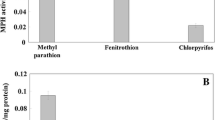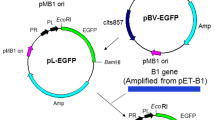Abstract
Field contamination with pesticide mixtures of organophosphates (OPs) and organochlorines (OCs) is becoming global issues to be solved urgently. The strategy of utilizing engineered microorganisms that have an ability to simultaneously degrade OPs and OCs has increasingly received great interest. In this work, an OP degradation gene (mpd) and an OC degradation gene (linA) were simultaneously introduced into Escherichia coli by using two compatible plasmids, resulting in strains with both OP degradation and OC degradation capabilities. To overcome the potential substrate uptake limitation, MPH was displayed on the cell surface of Escherichia coli using the N- and C-terminal domains of ice nucleation protein (INPNC) as an anchoring motif. The surface localization of INPNC–MPH was verified by cell fractionation, Western blot, proteinase accessibility, and immunofluorescence microscopy. Furthermore, both LinA and green fluorescent protein (GFP) were functionally co-expressed in the MPH-displaying Escherichia coli. The engineered Escherichia coli degraded OPs as well as OCs rapidly, and it can be easily monitored by GFP fluorescence.



Similar content being viewed by others
References
Kumar, S., Mukerji, K., Mukerji, K. G., & Lal, R. (1996). Critical Reviews in Microbiology, 22, 1–26.
Sogorb, M. A., Vilanova, E., & Carrera, V. (2004). Toxicology Letters, 151, 219–233.
Imai, R., Nagata, Y., Fukuda, M., Takagi, M., & Yano, K. (1991). Journal of Bacteriology, 173, 6811–6819.
Mulbry, W. W., & Karns, J. S. (1988). Journal of Bacteriology, 171, 6740–6746.
Dumas, D. P., Caldwell, S. R., Wild, J. R., & Raushel, F. M. (1989). Journal of Biological Chemistry, 264, 19659–19665.
Thomas, J. C., Berger, F., Jacquier, M., Bernillon, D., Baud-Grasset, F., Truffaut, N., Normand, P., Vogel, T. M., & Simonet, P. (1996). Journal of Bacteriology, 178, 6049–6055.
Wolber, P. K. (1993). Advances in Microbial Physiology, 34, 203–237.
Schmid, D., Pridmore, D., Capitani, G., Battistuta, R., Nesser, J. R., & Jann, A. (1997). FEBS Letters, 414, 590–594.
Chalfie, M., Tu, Y., Euskirchen, G., Ward, W. W., & Prasher, D. C. (1994). Science, 263, 802–805.
Patterson, G. H., Knobel, S. M., Sharif, W. D., Kain, S. R., & Piston, D. W. (1997). Biophysical Journal, 73, 2782–2790.
Larrainzar, E., O'Gara, F., & Morrissey, J. P. (2005). Annual Review of Microbiology, 59, 257–277.
Elväng, A. M., Westerberg, K., Jernberg, C., & Jansson, J. K. (2001). Environmental Microbiology, 3, 32–42.
Errampalli, D., Leung, K., Cassidy, M. B., Kostrzynska, M., Blears, M., Lee, H., & Trevors, J. T. (1999). Journal of Microbiological Methods, 35, 187–199.
Li, L., Yang, C., Lan, W., Xie, S., Qiao, C., & Liu, J. (2008). Environmental Science and Technology, 42, 2136–2141.
Yang, C., Cai, N., Dong, M., Jiang, H., Li, J., Qiao, C., Ashok, M., & Wilfred, C. (2008). Biotechnology and Bioengineering, 99, 30–37.
Gupta, R., Sharma, P., & Vyas, V. V. (1995). Journal of Biotechnology, 41, 29–37.
Novick, R. P. (1987). Microbiology and Molecular Biology Reviews, 51, 381–395.
Austin, S., & Nordstrom, K. (1990). Cell, 60, 351–354.
Studier, F. W., Rosenberg, A. H., Dunn, J. J., & Dubendorff, J. W. (1990). Methods in Enzymology, 185, 60–89.
Wang, A. A., Ashok, M., & Wilfred, C. (2002). Applied and Environmental Microbiology, 68, 1684–1689.
Nagata, Y., Hatta, T., Imai, R., Kimbara, K., Fukuda, M., Yano, K., & Takagi, M. (1993). Bioscience, Biotechnology, and Biochemistry, 57, 1582–1583.
de Lorenzo, V., Eltis, L., Kessler, B., & Timmis, K. N. (1993). Gene, 123, 17–24.
Acknowledgement
We honestly would like to thank Prof. Dr. Y. Nagata of Kyoritsu University for providing Sphingomonas paucimobilis UT26 for this work. This work was supported by grants from the 863 Hi-Tech Research and Development Program of the People's Republic of China (No. 2007AA06Z335 and 2009AA06A417).
Author information
Authors and Affiliations
Corresponding author
Rights and permissions
About this article
Cite this article
Yang, J., Liu, R., Song, W. et al. Construction of a Genetically Engineered Microorganism that Simultaneously Degrades Organochlorine and Organophosphate Pesticides. Appl Biochem Biotechnol 166, 590–598 (2012). https://doi.org/10.1007/s12010-011-9450-5
Received:
Accepted:
Published:
Issue Date:
DOI: https://doi.org/10.1007/s12010-011-9450-5




